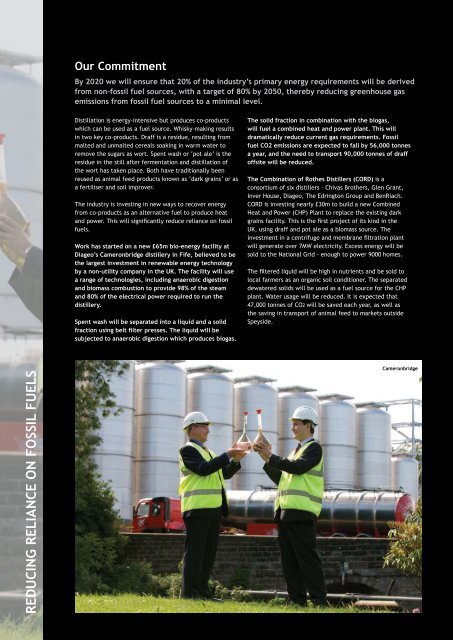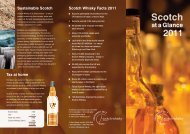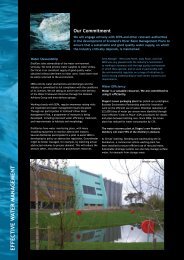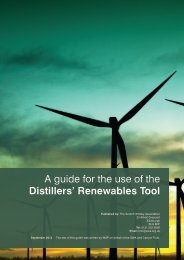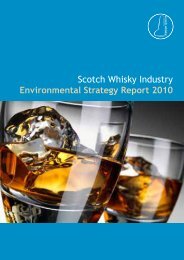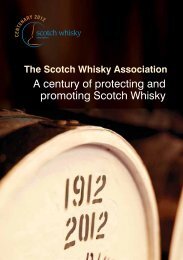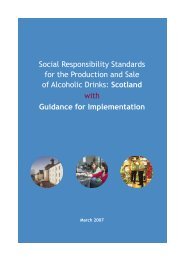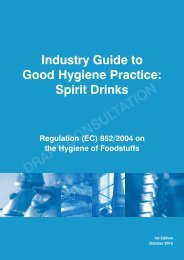Download the full case study - Scotch Whisky Association
Download the full case study - Scotch Whisky Association
Download the full case study - Scotch Whisky Association
Create successful ePaper yourself
Turn your PDF publications into a flip-book with our unique Google optimized e-Paper software.
Our Commitment<br />
By 2020 we will ensure that 20% of <strong>the</strong> industry’s primary energy requirements will be derived<br />
from non-fossil fuel sources, with a target of 80% by 2050, <strong>the</strong>reby reducing greenhouse gas<br />
emissions from fossil fuel sources to a minimal level.<br />
Distillation is energy-intensive but produces co-products<br />
which can be used as a fuel source. <strong>Whisky</strong>-making results<br />
in two key co-products. Draff is a residue, resulting from<br />
malted and unmalted cereals soaking in warm water to<br />
remove <strong>the</strong> sugars as wort. Spent wash or ‘pot ale’ is <strong>the</strong><br />
residue in <strong>the</strong> still after fermentation and distillation of<br />
<strong>the</strong> wort has taken place. Both have traditionally been<br />
reused as animal feed products known as ‘dark grains’ or as<br />
a fertiliser and soil improver.<br />
The industry is investing in new ways to recover energy<br />
from co-products as an alternative fuel to produce heat<br />
and power. This will significantly reduce reliance on fossil<br />
fuels.<br />
Work has started on a new £65m bio-energy facility at<br />
Diageo’s Cameronbridge distillery in Fife, believed to be<br />
<strong>the</strong> largest investment in renewable energy technology<br />
by a non-utility company in <strong>the</strong> UK. The facility will use<br />
a range of technologies, including anaerobic digestion<br />
and biomass combustion to provide 98% of <strong>the</strong> steam<br />
and 80% of <strong>the</strong> electrical power required to run <strong>the</strong><br />
distillery.<br />
Spent wash will be separated into a liquid and a solid<br />
fraction using belt filter presses. The liquid will be<br />
subjected to anaerobic digestion which produces biogas.<br />
The solid fraction in combination with <strong>the</strong> biogas,<br />
will fuel a combined heat and power plant. This will<br />
dramatically reduce current gas requirements. Fossil<br />
fuel CO2 emissions are expected to fall by 56,000 tonnes<br />
a year, and <strong>the</strong> need to transport 90,000 tonnes of draff<br />
offsite will be reduced.<br />
The Combination of Ro<strong>the</strong>s Distillers (CORD) is a<br />
consortium of six distillers – Chivas Bro<strong>the</strong>rs, Glen Grant,<br />
Inver House, Diageo, The Edrington Group and BenRiach.<br />
CORD is investing nearly £30m to build a new Combined<br />
Heat and Power (CHP) Plant to replace <strong>the</strong> existing dark<br />
grains facility. This is <strong>the</strong> first project of its kind in <strong>the</strong><br />
UK, using draff and pot ale as a biomass source. The<br />
investment in a centrifuge and membrane filtration plant<br />
will generate over 7MW electricity. Excess energy will be<br />
sold to <strong>the</strong> National Grid - enough to power 9000 homes.<br />
The filtered liquid will be high in nutrients and be sold to<br />
local farmers as an organic soil conditioner. The separated<br />
dewatered solids will be used as a fuel source for <strong>the</strong> CHP<br />
plant. Water usage will be reduced. It is expected that<br />
47,000 tonnes of CO2 will be saved each year, as well as<br />
<strong>the</strong> saving in transport of animal feed to markets outside<br />
Speyside.<br />
REDUCING RELIANCE ON FOSSIL FUELS<br />
Cameronbridge
Biomass burner building at Roseisle<br />
Roseisle employs anaerobic digestion to convert<br />
carbohydrates in distillery co-products into methane and<br />
‘clean’ water. The water is used in <strong>the</strong> malting process,<br />
whilst <strong>the</strong> methane is fed into a biomass boiler to reduce<br />
reliance on fossil fuels. The distillery is sited next to<br />
Diageo’s existing Burghead maltings, which allows waste<br />
heat from distilling to be diverted to <strong>the</strong> maltings plant,<br />
again minimising fossil fuel use and CO2 emissions from raw<br />
material transport.<br />
The combined technology offsets <strong>the</strong> distillery fossil fuel<br />
demand by 85%, with half <strong>the</strong> power requirements coming<br />
from biomass and biogas. This toge<strong>the</strong>r with <strong>the</strong> heat<br />
recovery system will recover 8.6Mw of <strong>the</strong> 10.2Mw demand.<br />
Work has now finished on Diageo’s new £40m malt whisky<br />
distillery at Roseisle in Moray. The plant has been built to<br />
<strong>the</strong> BREEAM standard, which is recognised as best practice in<br />
sustainable design.<br />
As a prototype project, Scottish Bioenergy is building a<br />
reactor at The Edrington Group’s Glenturret distillery,<br />
near Crieff. CO2 from <strong>the</strong> distillery boiler will be captured by<br />
algae growing in nutrient rich effluent. The biomass will be<br />
converted into oil which can be used as fuel and proteins for<br />
animal and fish food. The system has an added advantage in<br />
that <strong>the</strong> algae will remove copper from <strong>the</strong> effluent.<br />
Drawing of CORD bioenergy plant


